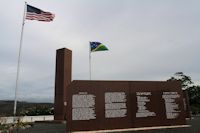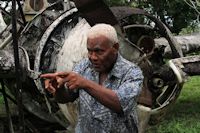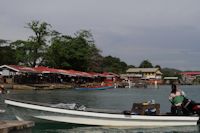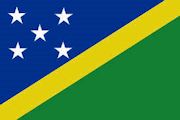Tikitouring
in a fabulous part of the world: Page 2
Richard Moore's article continues ...
 Soon
after landing in Honiara we went with a knowledgeable
battlefield guide, Michael Ramosaea, to the United States
Memorial high over the city on Skyline Ridge.
Soon
after landing in Honiara we went with a knowledgeable
battlefield guide, Michael Ramosaea, to the United States
Memorial high over the city on Skyline Ridge.
The
Stars and Stripes flies over the carved marble memorial
walls, together with the Solomon Islands flag.
The
inscriptions on the walls tell of the bloody battles
fought to clear the islands of the invading Japanese
and the high cost in lives that were claimed on the
land, in the air and on the sea.
Following that we headed about 50km west of the capital
to the Vilu
War Museum.
The
museum building is basic but when you go through to
the outside displays you see what the place is all about.
There
are the remnants of planes, engines and intact Japanese
artillery pieces.
 The
Vilu museum is inspiring and visitors making the effort
to see it will not be disappointed.
The
Vilu museum is inspiring and visitors making the effort
to see it will not be disappointed.
Our
first stopover was Gizo,
a hub town for the western province with a hotel, market
and hospital.
We
flew by small plane to the airstrip at Nusatupe near
Gizo. The airfield is built on two islands that have
been levelled.
From
there we were taken by motorised longboat - the taxis
of the outer regions - to the town of Gizo.
Arriving
by boat you see the red tin roofs of the open market
buildings and crowds of people already there.
 On
offer are coconuts, root vegetables, cucumbers, chillis
and later in the day, after the fishermen return, fresh
fish.
On
offer are coconuts, root vegetables, cucumbers, chillis
and later in the day, after the fishermen return, fresh
fish.
There
are also table after table of betelnuts – a mild intoxicant
much favoured by Solomon Islanders of all ages and one
that when mixed with lime colours the teeth and mouth
red.
The
Gizo
hotel is a good place to stay, it has
clean rooms, much needed air-conditioning and a really
good restaurant in which I had the most massive crayfish
for a very paltry sum.
But,
again like Honiara, Gizo is only a short-time base and
we head out on one of the longboats to the village of
Saeragi on the northern tip of Gizo island.
Continued
...






 Soon
after landing in Honiara we went with a knowledgeable
battlefield guide, Michael Ramosaea, to the United States
Memorial high over the city on Skyline Ridge.
Soon
after landing in Honiara we went with a knowledgeable
battlefield guide, Michael Ramosaea, to the United States
Memorial high over the city on Skyline Ridge.  The
Vilu museum is inspiring and visitors making the effort
to see it will not be disappointed.
The
Vilu museum is inspiring and visitors making the effort
to see it will not be disappointed.  On
offer are coconuts, root vegetables, cucumbers, chillis
and later in the day, after the fishermen return, fresh
fish.
On
offer are coconuts, root vegetables, cucumbers, chillis
and later in the day, after the fishermen return, fresh
fish. 



